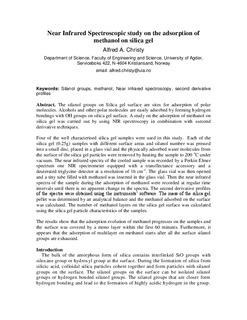| dc.contributor.author | Christy, Alfred A. | |
| dc.date.accessioned | 2013-05-13T11:21:19Z | |
| dc.date.available | 2013-05-13T11:21:19Z | |
| dc.date.issued | 2013 | |
| dc.identifier.citation | Christy, A. A. (2013). Near infrared spectroscopic study on the adsorption of methanol on silica gel. Advanced Materials Research, 650, 150-155. doi: 10.4028/www.scientific.net/AMR.650.150 | no_NO |
| dc.identifier.issn | 1022-6680 | |
| dc.identifier.uri | http://hdl.handle.net/11250/136958 | |
| dc.description | Author's version of an article in the journal: Advanced Materials Research. Also available from the publisher at: http://dx.doi.org/10.4028/www.scientific.net/AMR.650.150 | no_NO |
| dc.description.abstract | The silanol groups on Silica gel surface are sites for adsorption of polar molecules. Alcohols and other polar molecules are easily adsorbed by forming hydrogen bondings with OH groups on silica gel surface. A study on the adsorption of methanol on silica gel was carried out by using NIR spectroscopy in combination with ssecond derivative techniques. Four of the well characterised silica gel samples were used in this study. Each of the silica gel (0.25g) samples with different surface areas and silanol number was pressed into a small disc, placed in a glass vial and the physically adsorbed water molecules from the surface of the silica gel particles were removed by heating the sample to 200 °C under vacuum. The near infrared spectra of the cooled sample was recorded by a Perkin Elmer spectrum one NIR spectrometer equipped with a transflectance accessory and a deuterated triglycine detector at a resolution of 16 cm-1. The glass vial was then opened and a tiny tube filled with methanol was inserted in the glass vial. Then the near infrared spectra of the sample during the adsorption of methanol were recorded at regular time intervals until there is no apparent change in the spectra. The second derivative profiles of the spectra were obtained using the instruments' software. The mass of the silica gel pellet was determined by an analytical balance and the methanol adsorbed on the surface was calculated. The number of methanol layers on the silica gel surface was calculated using the silica gel particle characteristics of the samples. The results show that the adsorption evolution of methanol progresses on the samples and the surface was covered by a mono layer within the first 60 minutes. Furthermore, it appears that the adsorption of multilayer on methanol starts after all the surface silanol groups are exhausted. | no_NO |
| dc.language.iso | eng | no_NO |
| dc.publisher | Trans Tech Publications | no_NO |
| dc.subject | silanol groups | |
| dc.subject | methanol | |
| dc.subject | near infrared spectroscopy | |
| dc.subject | second derivative profiles | |
| dc.title | Near infrared spectroscopic study on the adsorption of methanol on silica gel | no_NO |
| dc.type | Journal article | no_NO |
| dc.type | Peer reviewed | no_NO |
| dc.subject.nsi | VDP::Mathematics and natural science: 400::Chemistry: 440 | no_NO |
| dc.subject.nsi | VDP::Technology: 500::Chemical engineering: 560 | no_NO |
| dc.source.pagenumber | 150-155 | no_NO |
| dc.source.journal | Advanced Materials Research | no_NO |
| dc.identifier.doi | 10.4028/www.scientific.net/AMR.650.150 | |
